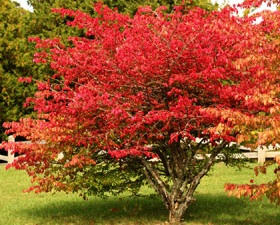Description
 Also called Winged Euonymus (Euonymus alata), this invasive plant can establish dense stands that outcompete other understory plants, as it blocks light and will overcrowd the other plants. Birds feed on the berries and spread the shrub. It was first introduced in the 1860s as an ornamental plant from northeastern Asia. Burning Bushes are often found in open woods, disturbed lands, and flood plains.
Also called Winged Euonymus (Euonymus alata), this invasive plant can establish dense stands that outcompete other understory plants, as it blocks light and will overcrowd the other plants. Birds feed on the berries and spread the shrub. It was first introduced in the 1860s as an ornamental plant from northeastern Asia. Burning Bushes are often found in open woods, disturbed lands, and flood plains.
ID
The leaves turn bright red in the fall, and they grow opposite along the stems. Yellow-green flowers bloom in the spring, but are inconspicuous, as they lie flat against the leaves. Red-purple fruits develop in late summer.
Management
Seedlings can be pulled manually, but larger shrubs must be cut. Glyphosate must be painted on the stumps, or can be sprayed on the foliage in early summer.
Alternatives
There are native plants that also have colorful foliage in the fall and are much better for the environment. These include Oak leaf Hydrangea, Highbush Blueberry, and Virginia Sweetspire.